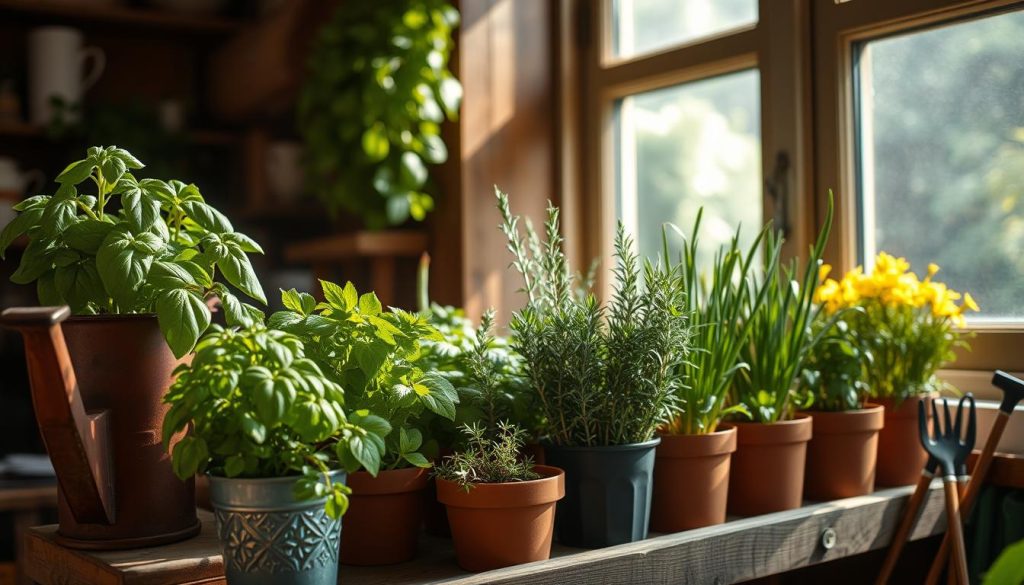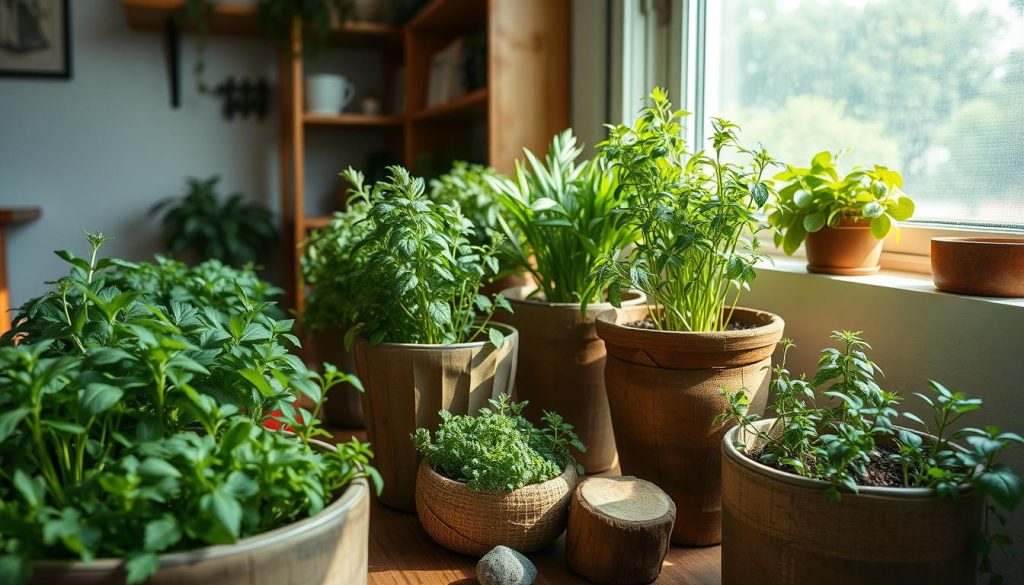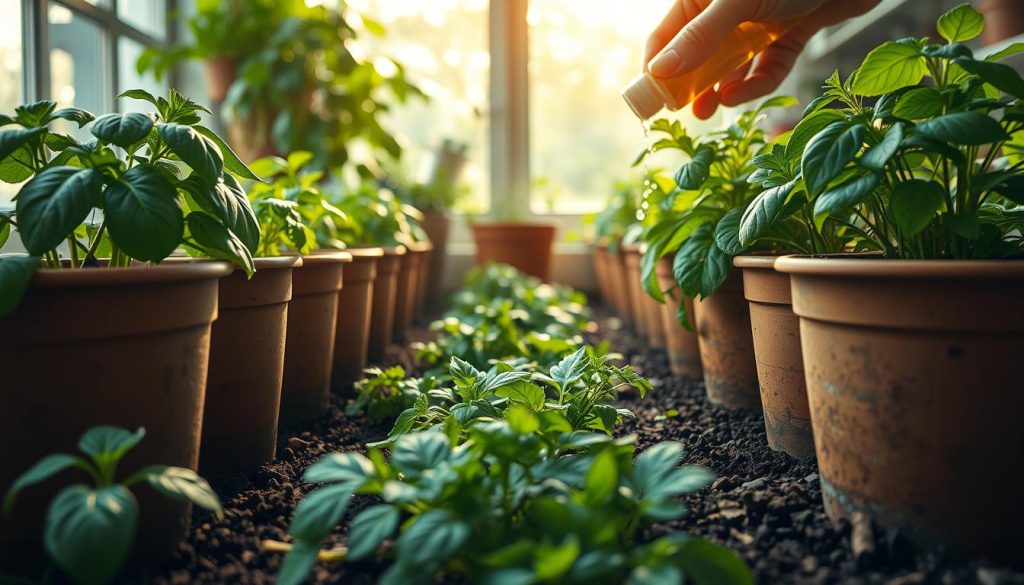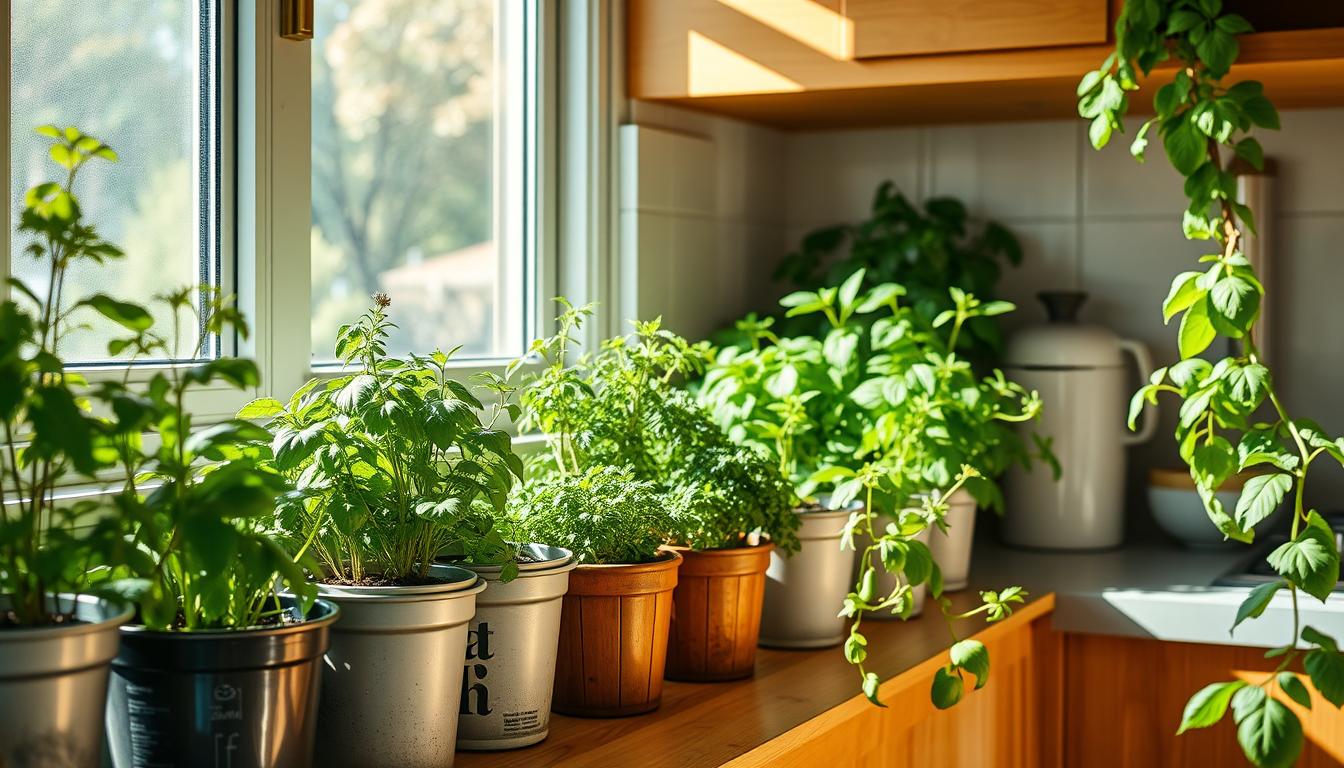I’m excited to share my experience growing herbs indoors without waste. To start, it’s key to know the basics of sustainable indoor herb gardening. With a few simple tips, anyone can create a beautiful, eco-friendly indoor herb garden.
In this article, I’ll share how to make your plant space waste-free. We’ll talk about choosing the right herbs and using eco-friendly materials. By following my tips, you can enjoy fresh herbs all year while being kind to the planet. Let’s start this journey to waste-free indoor herb gardening together!
Why Grow Herbs Indoors?
Growing herbs indoors is fun and rewarding. It lets you have fresh herbs all year. Eco-friendly herb growing helps the planet while you enjoy your homegrown herbs. You can control the environment, giving your herbs the right light, water, and nutrients.
Zero-waste indoor herb cultivation is good for the planet. Use recycled containers and upcycled kitchen scraps. Choose sustainable potting mix for a green garden. Some benefits include:
- Fresh herbs year-round, regardless of the season
- Control over the environment, allowing for optimal growing conditions
- Reduced waste and environmental impact
- Increased access to a variety of herbs, including rare or exotic species
Choose herbs that do well indoors and can grow all year. Basil, mint, and cilantro are great choices. Eco-friendly and zero-waste growing make indoor herb gardening sustainable and beneficial.
Choosing the Right Herbs for Indoor Growth
Choosing the right herbs is key for a successful indoor garden. I look at the light and temperature in my space. This helps me pick herbs that will do well.
I love growing basil, mint, and cilantro because they’re easy to care for. I also think about what each herb needs, like soil and water.
Popular Indoor Herbs
- Basil: a classic choice for indoor gardens, basil is easy to grow and can be used in a variety of dishes
- Mint: a hardy, fragrant herb that can thrive in partial shade and moist soil
- Cilantro: a fast-growing herb that prefers well-draining soil and full sun

Easy-to-Grow Varieties
I also look for easy-to-grow herbs like parsley, rosemary, and thyme. These herbs are low-maintenance and can handle some neglect. By mixing popular and easy herbs, I create a diverse and thriving garden.
Waste-Free Planting Techniques
To make your indoor herb garden eco-friendly, use waste-free planting methods. The key is to reduce, reuse, and recycle. This way, you can enjoy fresh herbs all year while being kind to the planet.
Choose recycled containers like old pots or jars for planting. This not only cuts down on waste but also makes your garden unique. You can also mix kitchen scraps like eggshells or coffee grounds into your soil. This makes your herbs grow well and reduces waste.
- Using compost to enrich your potting mix
- Repurposing old containers to create a unique planter
- Utilizing rainwater or greywater for irrigation
By following these tips, you’ll create a sustainable and lush indoor herb garden. It’s a great way to enjoy fresh herbs while helping the environment.
Creating the Perfect Indoor Environment
To keep your herbs healthy and growing well, you need to create the right indoor space. This means thinking about light, temperature, and humidity. By getting these right, you can help your herbs grow strong and produce lots of leaves.
Light is key for growing herbs indoors. Most herbs need lots of light to make food and grow. You can use grow lights to help if it’s dark outside, like in winter or in shady places.
Optimizing Light and Temperature
Here are some tips to make sure your herbs get the right light and temperature:
- Put herbs near a sunny window or use grow lights for 4-6 hours of direct light
- Keep the temperature steady between 65-75°F (18-24°C) during the day
- Don’t put herbs near heating or cooling vents, fireplaces, or drafty windows

Humidity and Air Circulation
Humidity and air movement are also important for your herbs. You can raise humidity by putting plants on a tray with water and pebbles or using a humidifier. Good air flow helps prevent diseases and keeps your herbs healthy.
Watering Your Herbs Efficiently
Proper watering is key for a healthy indoor herb garden. As I delve into zero-waste herb growing, I’ve found that efficient watering is vital. Here, I’ll share tips on creating a watering schedule, using self-watering containers, and checking moisture levels.
First, understand how much water your herbs need. Water them when the top inch of soil feels dry. But, this can change based on the herb type, container size, and home humidity. Here are some ways to water without waste:
- Use self-watering containers with a built-in water reservoir
- Check soil moisture with a moisture meter
- Water in the morning so plants can absorb it all day
By following these tips, you can grow a beautiful, sustainable indoor herb garden. Keep an eye out for signs of too much water, like yellow leaves or soft stems. Adjust your schedule as needed. With practice and patience, you’ll get the hang of growing herbs without waste and enjoy fresh herbs all year.
Fertilizing Your Indoor Herbs
To keep my indoor herbs healthy, I focus on organic and green fertilizing methods. This fits my goal of farming herbs indoors without waste. Organic fertilizers help create a rich environment for my herbs to thrive.
Composting is a great way to fertilize my herbs. It lets me use kitchen scraps and cut down on waste. This compost feeds my herbs, giving them the nutrients they need to grow well.
Timing Your Feedings
Getting the timing right for fertilizing is key. I plan my fertilizations based on each herb’s needs. This ensures my garden stays balanced and healthy, all while being eco-friendly.

Choosing Organic Fertilizers
I choose organic fertilizers to avoid harsh chemicals. Some good options include:
- Fish emulsion
- Compost tea
- Worm casting
These organic choices give my herbs the nutrients they need. They also support my eco-friendly herb growing goals.
Harvesting and Using Your Herbs
Exploring waste-free indoor herb garden tips has shown me the value of harvesting and using herbs right. Green indoor herb gardening practices help me enjoy a full harvest while cutting down on waste.
To get the most from my herbs, I’ve learned a few key harvesting tips. I harvest them when the leaves are at their best flavor and smell. I use scissors or pinch off leaves to avoid harming the plant.
Preserving Leftover Herbs
Preserving leftover herbs is a challenge in indoor gardening. To solve this, I’ve started using a few methods, including:
- Drying: I tie my herbs in small bunches and hang them upside down in a warm, dry place.
- Freezing: I chop my herbs finely and freeze them in ice cube trays filled with water or oil.
- Infused oils: I steep my herbs in a neutral oil, such as olive or grapeseed, to create a flavorful oil that can be used in cooking.
Cooking Tips with Fresh Herbs
I love trying new recipes that highlight the fresh flavors of my herbs. Favorites include herb-infused soups, salads, and sauces. By using waste-free indoor herb garden tips and green practices in cooking, I reduce my environmental impact and enjoy delicious, homegrown herbs.
Troubleshooting Common Issues
Keeping your indoor herb garden healthy requires some troubleshooting. Look out for pests like holes in leaves or tiny bugs. Use organic pest control, like introducing beneficial insects or insecticidal soap, to fight them off.
Watch for signs of disease like discoloration, wilting, or mold. Use organic fungicides or improve air circulation to fix these problems. This way, you can keep your herbs healthy and pest-free.
If your herbs start to wilt, don’t worry. You can usually fix it with a little care. Check if the soil is too dry or too wet. Adjust your watering and consider a nutrient boost with organic fertilizer.
By tackling these common issues, you’ll have a thriving indoor herb garden. It will give you fresh, tasty ingredients all year.

